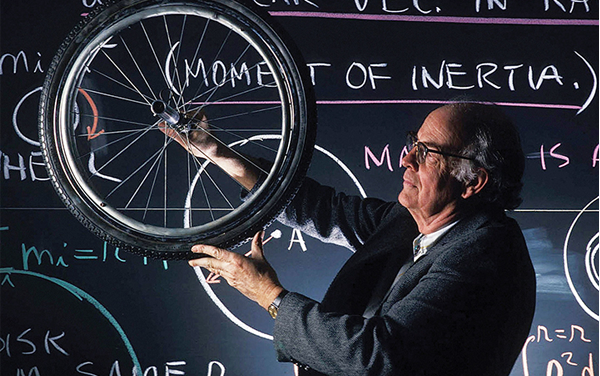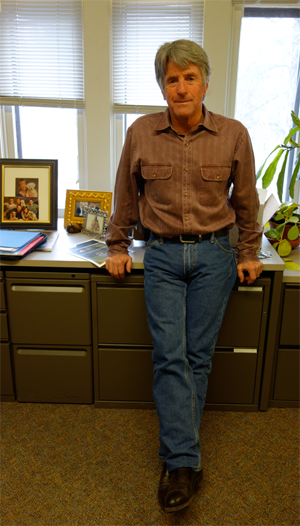Science communication efforts inspire largest gift yet for CU Sustainability Complex
Legendary CU physics professor Albert Bartlett, who worked at Los Alamos National Laboratory for the Manhattan Project in 1944 before his 38-year tenure on CU’s faculty.
Inspired by melting glaciers and CU scientists’ efforts to educate the public about mechanisms that drive environmental change, emeritus Department of Communication faculty member Brian Daniell and his wife, Vicki Bynum, have stepped forward to pledge $500,000 toward CU-Boulder’s Sustainability, Energy, and Environment Complex (SEEC).
The commitment will establish the Albert A. Bartlett Science Communication Center on the second floor of SEEC. The center will be a place for information exchange among students and scholars from CU and beyond, as well as federal researchers and community members, with the overarching themes of sustainability and collaboration.
When completed in 2015, SEEC will consist of 430,000 square feet of research labs, classrooms, and other academic spaces on East Campus—serving as a catalyst and national hub for learning, research and innovation. SEEC’s partners include CU programs and federal labs such as the Institute of Arctic and Alpine Research (INSTAAR), the Renewable & Sustainable Energy Institute (RASEI), the National Renewable Energy Laboratory (NREL), and CU’s Environmental Studies Program, among others.
Vicki Bynum chose the name to honor legendary CU physics professor Albert Bartlett, who worked at Los Alamos National Laboratory for the Manhattan Project in 1944 before his 38-year tenure on CU’s faculty. He warned about the consequences of human overpopulation and the resulting depletion of resources and environmental degradation, giving his famed “Arithmetic, Population and Energy” lecture over 1,700 times before he passed away last September.
“The clarity and power of this lecture, and the energy with which he gave it over a period of decades, made him a quintessential science communicator and the archetype for the kind of people that we hope the new center will develop and support,” Daniell says.
Bartlett played an instrumental role in the establishment of Boulder’s open space policies. As a CU donor, Bartlett inspired a scholarship for CU physics students with aspirations to teach in high schools. His efforts to reach as many citizens as possible about sustainability issues will live on at SEEC.
As a Communication instructor, Daniell integrated sustainability issues into his lectures as he became increasingly concerned about climate change. In 2008 he created the Communication Project for Civic and Social Engagement (CASE), providing internship opportunities that enable CU-Boulder Communication students to serve environmental sustainability interests in their communities.
“That year I began to look for opportunities for students in my discipline to participate in and contribute to wider efforts to disseminate the threat of climate change to the general public,” Daniell says. “My original motivation in this effort was to explore partnerships with the scientific community.
“Vicki and I have done two trips to Antarctica, the first to South Georgia Island and the Antarctic Peninsula in 2008. In 2011, we spent a month on a Russian ice breaker in the Ross Sea. Last year we visited Finnmark in the Norwegian Arctic. Every time we go outside, whether on a hike in the foothills west of Boulder or to British Columbia, the Arctic or the Antarctic, we become more attuned to the fragility and the preciousness of our planet, its wildlife and wild places,” Daniell says.
Daniell’s teaching experience and travels to the Arctic sparked conversations with INSTAAR Director, Jim White, the primary academic liaison for SEEC. Daniell envisions the complex of SEEC buildings, for which the effort to raise private support is intensifying, as a new way to learn—influenced as much by outside forces as by university leaders.
“Donations made toward SEEC today,” Daniell says, “will be instrumental in creating a key facet of the university of the future.”
“Building a resilient future for us all is a major challenge for the coming decades,” White says. “It is our responsibility, as Colorado’s flagship university, to help search for solutions, train the problem-solvers of the future, and communicate what we know to the people of our state. That communication piece is so vital to forming a working partnership with Coloradans, and Vicki and Brian’s generous gift in Al Bartlett’s name is key to ensuring that the communication continues and improves.”



